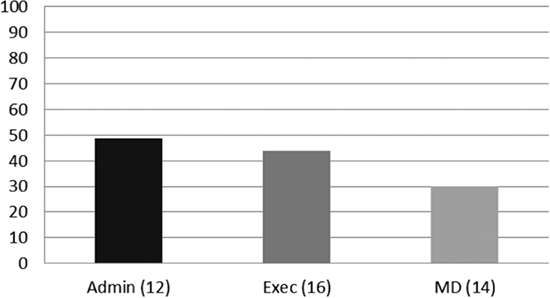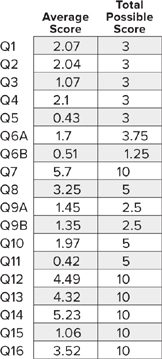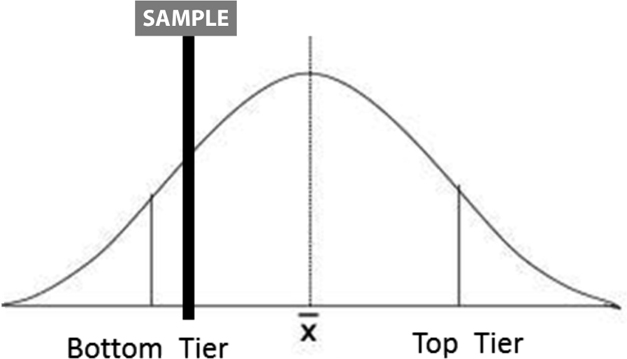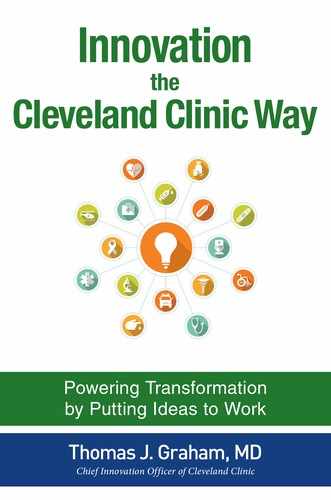Sample Medical Innovation Maturity Survey (MiMS) Results
The intent of the MiMS is to define objectively an organization’s cultural innovation maturity. Forty-two individuals completed the entire MiMS. While the number of respondents is fewer than anticipated, it is sufficiently significant to understand the organization’s innovation status. The overall survey has a maximum score of 100. Figure C.1 shows SAMPLE’s average score broken down by major job categories. In parentheses are the numbers of individuals completing the entire survey for that job category. The median score is 42.7. The mean score is 40.08. The lowest score is 11.24, one of 12 scores that was under 20 points (all from respondents who categorized themselves as physicians), and the highest score is 76.20 (C-suite individual). The disparity in scoring by job category is the highest ever seen in an organization completing the MiMS, indicating a significant divergence in opinion of SAMPLE’s people, process, and philosophy associated with innovation and commercialization.
FIGURE C.1 SAMPLE MiMS Results

Overall, scores are low when compared to organizations with a fairly robust commercialization office. However, lower scores are expected and not unusual for organizations that don’t have a functioning commercialization arm. The scores for each job group are fairly consistent with the answers given during the Graded Perspective Analysis (GPA) individual interviews. The scores of most organizations surveyed fall within a fairly tight range, but SAMPLE has a significant deviation in scoring range.
There is a clear difference in scoring between clinicians/physicians and the administration/executive level, as also seen in the GPA. Executive and administration leaders answered that the organization is far more mature in its commercialization and innovation structure and has a significantly stronger infrastructure in place. Executive and nonphysician administration MiMS scores are almost 60 percent higher than those of physicians. This is a clear and strong message that organizational support for innovation has not been effectively communicated to physician staff.
Unfortunately, a significant number of physicians asked to take the MiMS either didn’t begin or didn’t complete the survey. The lack of participation by key stakeholders provides a data point regarding how engaged they are in the innovation and commercialization function. Physicians scored the organization as having little, if any, infrastructure in place and little support for innovation and commercialization.
On the MiMS, executive leaders scored an average of 43.8 on a 100-point scale. Physician scores were significantly lower, averaging 35.66, while administration’s average score was 36.44. For benchmark comparison, organizations with established commercialization functions typically score around 73. As indicated earlier, the 60 percent differential in scores between physicians and administrators should serve as a catalyst for evaluating how innovation opportunities, organizational capabilities, and effective innovative changes are communicated to staff.
Overall, the organization’s score concludes that there is an organizational need to implement or adjust numerous functions in support of a comprehensive, sustainable commercialization program. Capabilities must also be communicated to staff in a manner that engages and supports them throughout the commercialization process.
The average MiMS scores by question and the total possible average scores per question are noted in Figure C.2. The two questions receiving the highest responses are Q1 and Q4. Q1 asked whether innovations are encouraged/accepted from one or more of constituent groups. As noted earlier, self-identified SAMPLE executives scored this question very highly (2.13), while physicians scored this question significantly lower (1.56). Q4, which asked about dedicated physical and virtual space for innovation, had the second highest score. Again, self-identified SAMPLE executives scored this question very highly (2.30). Physicians scored this question considerably lower (1.17), indicating a lack of awareness of space, resources, and support capabilities for innovation.
FIGURE C.2 SAMPLE MiMS Scores by Question

Conversely, Q5 and Q15 were the lowest. Q5 dealt with marketing infrastructure. Q15 asked what resources the institution directly invests or leverages for commercialization purposes. Both questions are tied to capabilities and infrastructure currently in place to support innovation and commercialization. Most respondents score the organization poorly regarding capabilities in place to support commercialization.
Historically, MiMS scores are lower at community-based health providers compared to academic medical centers. Because community-based systems typically lack significant research operations and funding for invention, ideas come from a much smaller portion of the staff population. Ideas are usually intermittent, opportunistic “lighting strikes,” as opposed to by-products of strategic ideation around identified unmet market needs.
The MiMS looks at three distinct areas of innovation maturity within the organization:
![]() People. Provides an understanding of the individuals in place and their commercialization skill set, as well as the associated physician staff’s desire and sophistication with regard to the commercialization process.
People. Provides an understanding of the individuals in place and their commercialization skill set, as well as the associated physician staff’s desire and sophistication with regard to the commercialization process.
![]() Process. Policies, procedures, and infrastructure in place to support commercialization activities.
Process. Policies, procedures, and infrastructure in place to support commercialization activities.
![]() Philosophy. Overall support for innovation across the organization. This includes the celebration of both successes and failures, the administration for inventors, and the handling of disruptive changes through new procedures and treatments that improve existing patient treatments.
Philosophy. Overall support for innovation across the organization. This includes the celebration of both successes and failures, the administration for inventors, and the handling of disruptive changes through new procedures and treatments that improve existing patient treatments.
People
MiMS questions relating to the human resource support and skill set of individuals in place across the enterprise for commercialization of innovations have the most widespread variability in answers. When asked whether innovation was accepted across various constituent levels in the organization (Q1), self-identified SAMPLE executives indicate that all constituents, including external innovators, are encouraged to bring ideas to the organization for development and implementation. Self-identified physicians and patient caregivers had a much more modest response, with nearly a third indicating that innovation is encouraged and accepted only by executives and physicians. This inconsistency in scoring between constituency levels is seen throughout the MiMS results.
When asked how connected the organization is with the marketplace (Q10), SAMPLE executives gave SAMPLE significantly higher scores than physicians. Most executive-level respondents indicated that SAMPLE is connected to the marketplace with semi-structured exchanges on innovation to fill its core needs. On the other hand, physicians answered that the organization either is disconnected or has more of a client/vendor commercialization relationship.
Overall, SAMPLE executives identified SAMPLE as having much more full-bodied innovation opportunities, internal and external relationships, and investment in the people component of innovation.
Process
The most aligned scores among all individuals, regardless of identified position within the organization, were related to questions about the processes in place for innovation and commercialization support. Most individuals answered that the organization does not have significant processes in place. Most responded that aligned and understood innovation and commercialization metrics are not disseminated or embraced by the organization (Q3). The majority of individuals answered that metrics employed for innovation across the institution are in place, but not disseminated or embraced.
When asked about dedicated space for innovation (Q4), executives generally answered that there is laboratory or incubator space for innovation. Nonexecutives typically said that there is no space or only borrowed space for innovation. This question has the least alignment based on the identified position of the respondent.
Overall, the second most consistent answer relates to the question on communication and marketing infrastructure supporting the innovation platform (Q5). Seventy-five percent of respondents indicated that there is a limited amount of internal communication and no external awareness. This answer is fairly common in an organization that doesn’t have a dynamic innovation process in place.
Philosophy
The most consistent answer to the questions around philosophy (culture) involved the domains of innovation being cultivated in the organization (Q6). More than 90 percent of respondents indicated that the organization focuses solely on supporting innovation related to institutional process/know-how. These findings are consistent with what was communicated during the interview process and aligns with answers given about resources available for commercialization.
Innovation is often categorized as fast, frugal failure, with commercially viable opportunities quickly identified and acted upon. Successful innovative organizations celebrate innovation and believe that participation, recognition, and reward are critical for program success. Most physicians indicated that SAMPLE has a tolerant or permissive environment for innovation but lacks a celebrated culture (Q8). SAMPLE executives tended to answer that the organization supports innovation and has resources in place to support proof of concept without negative consequences resulting from a failed attempt.
Figure C.3 summarizes where SAMPLE falls on the innovation maturity bell curve. Overall, scores from the MiMS put SAMPLE just above the bottom tier. Without some modest innovation success in business processes, SAMPLE would most likely fall near or below the bottom tier. Recognize that the focus of the MiMS and other components of the diagnostic looked at translating ideas and opportunities outside the organization.
FIGURE C.3 SAMPLE MiMS Maturity on the Bell Curve

Based on the MiMS survey, there is a clear disconnect in the understanding of capabilities, support, and innovation infrastructure response. High-level administration identifies the organization as being much more capable and encouraging of innovation than other groups across the organization. The capabilities that leadership believes it has in place have not cascaded throughout the organization and in particular have not been identified as a strong suit by physicians employed by the organization and those physicians working at a SAMPLE facility.
The lack of understanding around innovation maturity requires the organization to review its capabilities and determine more precisely what support is truly available. These capabilities must then be communicated across the enterprise, supported, and continually reintroduced to all constituents on a consistent basis.
